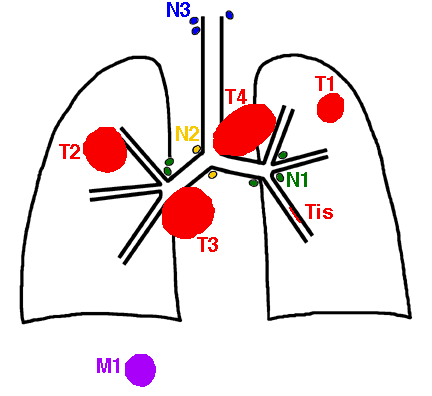
肿瘤的分期
肿瘤的分期和分级是对恶性肿瘤而言的,对恶性肿瘤的治疗和预后有重要意义。国际通用的是TNM分期法,T:肿瘤大小及局部浸润范围,N:淋巴结受累情况,M:远处转移。图示肺癌分期
| 恶性肿瘤分期 |
| 分期 |
定义 |
| Tis |
原位,无浸润(局限于上皮内) |
| T1 |
原发部位较小 |
| T2 |
原发部位较大 |
| T3 |
更大和或浸润超过了原发器官的边缘 |
| T4 |
非常大和(或)浸润到邻近器官 |
| N0 |
没有淋巴结转移 |
| N1 |
局限性淋巴结转移 |
| N2 |
广泛的淋巴结转移 |
| N3 |
更多远处淋巴结转移 |
| M0 |
无远处转移(血道转移) |
| M1 |
远处转移(血道转移)
Staging and grading schema have been devised for malignant neoplasms, because the stage and/or grade may determine the treatment and the prognosis. In general, the higher the stage, the larger a neoplasm is and the farther it has likely spread.
Staging
The most common systems for staging employs the TNM classification. A "T" score is based upon the size and/or extent of invasion. The "N" score indicates the extent of lymph node involvement. The "M" score indicates whether distant metastases are present. Staging forms have been devised for each organ or site that a malignant neoplasm can occur, and the criteria listed on the form. The forms are filled out using clinical and pathologic criteria and aid in determination of therapy, estimating the prognosis, and developing statistics useful for determining outcomes.
In the diagram below utilizing a lung carcinoma as an example, the principles of staging are illustrated:
| Staging of Malignant Neoplasms |
| Stage |
Definition |
| Tis |
In situ, non-invasive (confined to epithelium) |
| T1 |
Small, minimally invasive within primary organ site |
| T2 |
Larger, more invasive within the primary organ site |
| T3 |
Larger and/or invasive beyond margins of primary organ site |
| T4 |
Very large and/or very invasive, spread to adjacent organs |
| N0 |
No lymph node involvement |
| N1 |
Regional lymph node involvement |
| N2 |
Extensive regional lymph node involvement |
| N3 |
More distant lymph node involvement |
| M0 |
No distant metastases |
| M1 |
Distant metastases present
| |

